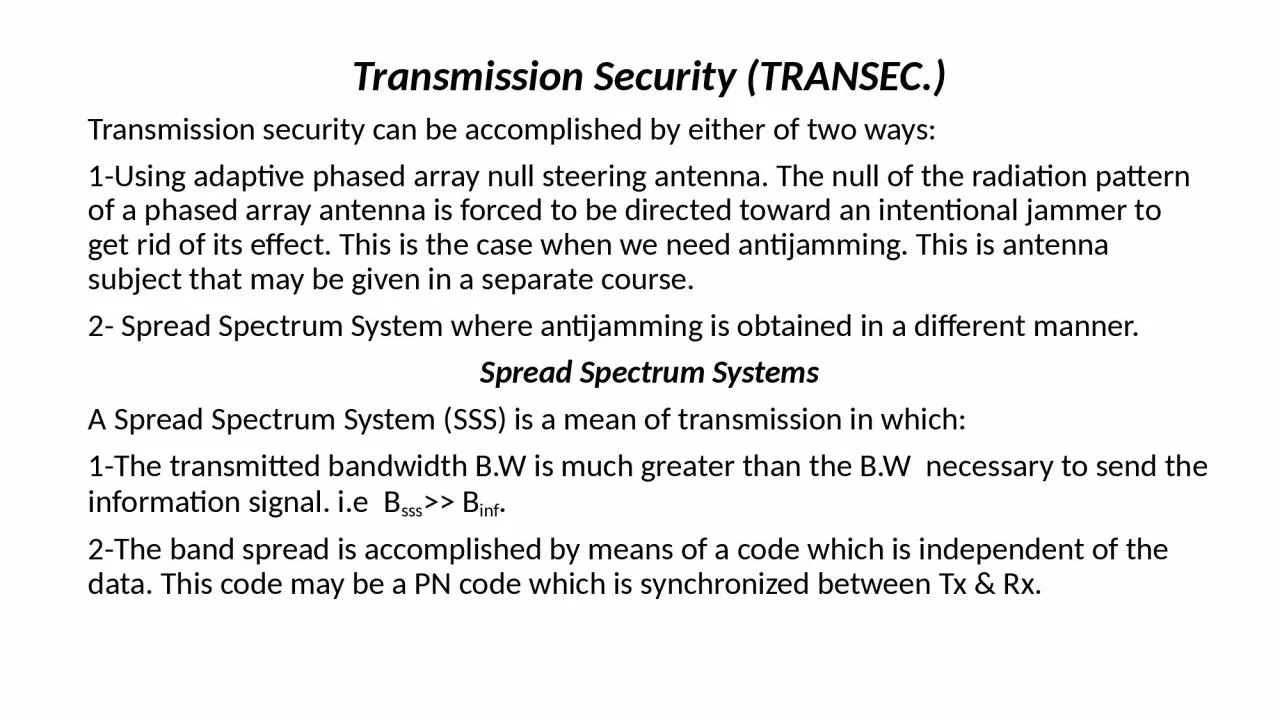

Transmission security can be accomplished by either of two ways 1Using adaptive phased array null steering antenna The null of the radiation pattern of a phased array antenna is forced to be directed toward an intentional jammer to get rid of its effect This is the case when we need ID: 1030622
Download Presentation The PPT/PDF document "Transmission Security (TRANSEC.)" is the property of its rightful owner. Permission is granted to download and print the materials on this web site for personal, non-commercial use only, and to display it on your personal computer provided you do not modify the materials and that you retain all copyright notices contained in the materials. By downloading content from our website, you accept the terms of this agreement.
1. Transmission Security (TRANSEC.)Transmission security can be accomplished by either of two ways:1-Using adaptive phased array null steering antenna. The null of the radiation pattern of a phased array antenna is forced to be directed toward an intentional jammer to get rid of its effect. This is the case when we need antijamming. This is antenna subject that may be given in a separate course.2- Spread Spectrum System where antijamming is obtained in a different manner.Spread Spectrum SystemsA Spread Spectrum System (SSS) is a mean of transmission in which:1-The transmitted bandwidth B.W is much greater than the B.W necessary to send the information signal. i.e Bsss>> Binf.2-The band spread is accomplished by means of a code which is independent of the data. This code may be a PN code which is synchronized between Tx & Rx.
2. Standard modulation schemes such as AM, FM, PCM, DM …. Which also spread the spectrum of the information signal are not considered as spread spectrum systems since there is no spreading code.Applications:1-Antijamming (ECCM which stands for Electronic Counter Counter Measure).2- Anti-interference.3-Low probability of intercept.4-Selective addressing.5-Code Division Multiple Access (CDMA).6-High resolution ranging.7-Low density for signal hiding.8-Accurate universal timing.9-Message screening from eavesdroppers.
3. Assuming that the receiver is ideal with no loss of information, then C at its input and output are the same, i.e:BrfSSS log2(1+SNRI) = Binf log2(1+SNRo) or: And if , which is called the process gain, then: and since SNRI is usually is very small ( SNRI << 1) for SSS, then: SNRo = Gp SNRI (recall that (1+x)n ≈ 1+nx if x << 1) Concept & Process GainReceiverchannelThe idea behind SSS can be drawn from the well known Shannon equation: C=B log2(1+SNR) (SNR)o SNR)I, BrfSSS Binf
4. i.e the advantage obtained in the SNR is the same as the ratio of the bandwidth expansion or the Process Gain Gp.Antijam Capability: In transec systems, the requirement is to make sure that the transmitted signal will not be jammed by the 3rd party or the 3rd party has no ability to receive, demodulate and understand the information. data Spreaded BrfSSS correlator data Spreading signal (wide-band) synchronized despreading signal (wide-band) Indicates wide band signal indicates narrow band baseband information FilterBinf
5. Previous figure shows the principle of most SSS. At Tx side the band expansion is accomplished by any spreading modulation method. Despreading at the Rx is done by correlating the received SSS signal with identical synchronized wide band code.If perfect synchronization is accomplished, the desired signal collapses to its original bandwidth, whereas any unwanted signal (such as noise, fading interference, multiuser interference and jamming) will be uncorrelated with the received coded signal and will be spread by the Tx local code. informationBinfspreadingSpreaded informatonBrfSSStransmittingreceivingundesiredBrfSSSdespreadinginformationundesired
6. Jamming Margin:Let J be the total jamming power in Watts, then: which is the average jamming density in W/HzLet P=received signal power, Rinf = data rate that specifies Binf, then the received energy per bit will be:It is well known that the BER (bit error rate) in any digital communication system is a function of the ratio Sb/No which is expressed as:From which: =jamming power to signal power assuming that Binf = Rinf
7. Here, the ratio of J/P is maximum jamming power to signal power and Sb/No is the minimum energy per bit to jamming spectral density ratio needed for reasonable reception of the digital signals. The ratio of (J/P) is called jamming margin (JM). This ratio can be expressed in dB as:JM (in dB) = 10 log10 Gp – 10 log10 (Sb/No) = Gp(in dB)- (Sb/No) (in dB)If some power losses are assumed at the Rx, then:JM ( in dB) = Gp(in dB)- [(Sb/No) (in dB)+ Ls(in dB)]Typical numbers are: Gp=20dB, (Sb/No)=9dB, Ls=1dB, then: JM=10dB, which means that this spread spectrum system can stand unwanted jamming power 10 times the received desired power and still gives BER with the acceptable limit determined by(Sb/No).
8. Types of Spread Spectrum Systems (SSS):Spread spectrum signals are classified into many basic types:1-Direct Sequence SSS . DS-SSS.2-Frequency Hopping SSS. FH-SSS.3-Time Hopping SSS. TH-SSS.4-Pulse-FM or chirp (radar applications)5-Hybrids. i.e DS-SSS followed FH-SSS or, FH-SSS followed by DS-SSS, TH-SSS/DS-SSS ….etcThese basic spread spectrum systems are different by their modulation formats.Only the 1st and 2nd types of above SSS will be explained in details since they are widely used in communication. The 3rd type is rarely used, while the 4th type can be studied in radar course.